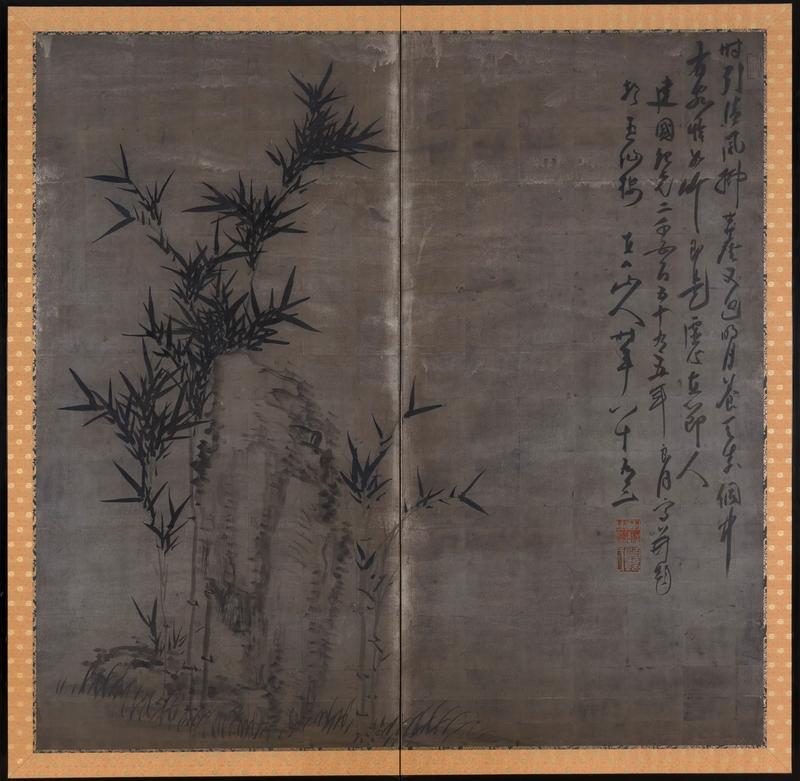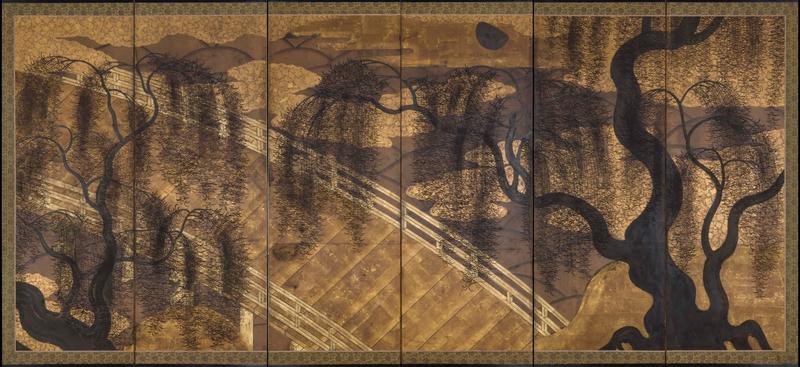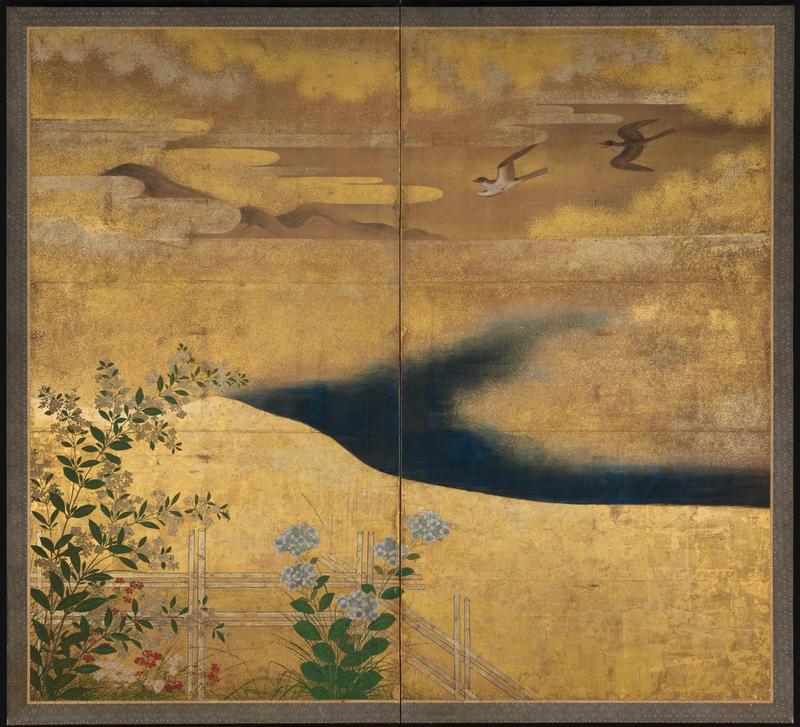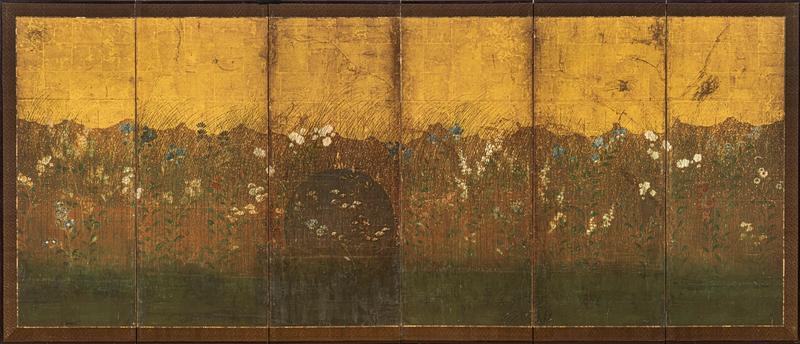A paper screen with the Uji river and its bridge
#7846
Hasegawa School
H. 172.5cm x W. 375.5cm (68” x 147.¾”)
A six-fold paper screen painted in ink and colour with the Uji river and its bridge, a silver moon, willows and a jakago (rock filled basket) amongst golden clouds.
Hasegawa School.
Japan, 16th/17th century, Momoyama/Edo period.
Provenance: a private American collection.
Acquired in Japan in the 1930s by Stella Coe (1900-?) author of ‘Ikebana’ (published in 1984) and pupil of Sōfū Teshigahara (1900-1979) founder of the Sōgetsu school of ikebana. The screen was restored and remounted by the conservator Mr Watanabe in Bucks County PA in the 1960’s then by descent to the previous owner.
This screen with its depiction of the famous Bridge at Uji is from a genre of Yamatoe-e (Japanese painting) known as meisho-e (paintings of famous places). It is executed with a luxurious combination of gold leaf (both solid and scattered irregularly) and gold paint of contrasting hues and reflectivity. The Uji river tosses up delicate arabesques among its swells as it rushes across the six panels. Reading from right to left one is drawn into this other worldly vision by the expansive golden bridge. Graceful willow trees mark the passing seasons and a waxing moon in silver leaf hangs amongst the clouds in the distance.
Japanese poets have long praised the scenic beauty of the Uji River which flows from Lake Biwa to Osaka Bay. Literary references to the location abound in imperial poetry and pre-date any existing images. The Man’yōshū (Collection of Ten Thousand Leaves, eighth century) and the Kokinshū (Collection of Poems from Ancient and Modern Times, early tenth century) include references to such features as the arching bridge (first constructed in 646 A.D.), trailing mist, the moon, rock-filled baskets, waterwheels, willows and rushing torrents, while hinting at the religious associations of this area.
In the eleventh century, Uji became home to the Pure Land (Jōdo) Buddhist temple Byōdoin and its famous Hōōdō (Phoenix Hall). The temple and its grounds are intended as a representation of Amida Buddha’s Western Paradise, a three-dimensional construction based on the Kanmuryōjukyō (Contemplation Sutra). Such literal manifestations of imaginary locations helped the aristocracy envision Paradise, a place they clearly hoped to return to after death. If these screens are read in the light of religious connotations, then perhaps the bridge represents the connection between this land and the Pure Land.
The Hasegawa School was founded by Hasegawa Tōhaku (1539-1610) in the late 16th century. Despite being small, consisting mostly of Tōhaku, his sons and sons-in-law it is known today as one of the most influential artistic groups of the period. Its members conserved Tōhaku's quiet and reserved aesthetic, which many attribute to the influence of Sesshū Tōyō (1420-1506) as well as his contemporary and friend, Sen no Rikyū (1522-1591).
Tōhaku's most noted contemporary, Kanō Eitoku (1543-1590) often competed with Tōhaku for the patronage of Toyotomi Hideyoshi (1536-1598). After Eitoku's death in 1590, Tōhaku stood alone as the greatest living master of his time. Becoming an official painter for Hideyoshi, producing some of his greatest and most elegant paintings. He and his atelier produced the wall and screen paintings in Shoun-ji temple commissioned by Hideyoshi in 1593 and later moved to Chishaku-in Temple, Kyoto.
According to the Tōhaku gasetsu, a contemporary account of Tōhaku, his interest in painting waves was inspired by the words of Tang-dynasty poet Du Fu when writing about the contemporary painter Wang Zai ‘Five days to paint a rock, ten days to paint a drop of water’. It is also recorded in Tōhaku gasetsu that Tōhaku possessed a copy of a pair of screens of waves which were owned by Hosokawa Nariyuki, patron of the famous painter Tōshun (fl. 1506-1542).
At the age of 67 Tōhaku was summoned to Edo and granted the priestly title of Hōgen by the Shōgun Tokugawa Ieyasu and remained in the capital for the rest of his life.
This subject matter was very popular from the Momoyama (1568-1603) to early Edo (1603-1868) and there are approximately thirty or so known examples (many in pairs), surviving today the majority of which are held in the collections of international museums.
For pairs of six-fold screens depicting this subject matter see:
Nihon Byōbu-e Shūsei no.9 Keibutsu-ga, p.43 pl. 21/22;
Hasegawa Tōhaku: 400th Memorial Retrospective, Kyoto National Museum and Tokyo National Museum, p.144-147, pl 43;
Beyond Golden Clouds, Japanese screens from the Art Institute of Chicago and the St Louis Art Museum, p.124/5. pl.10;
Bridge of Dreams, The Mary Griggs Burke Collection of Japanese Art, p.202 pl.80;
Kosetsu Museum, Ryūkyōsuishazu no sekai [Golden Dreams: Exploring Willow Bridge and Waterwheel], (Japan, 2021);
and visit:
- https://www.metmuseum.org/art/collection/search/53241 (the Metropolitan Museum of Art);
- https://collections.artsmia.org/art/91460/willow-bridge-and-water-wheel-unknown-japanese (the Minneapolis Museum of Art);
- https://colbase.nich.go.jp/collection_items/kyohaku/A甲12?locale=en#&gid=null&pid=2 (Kyoto National Museum);
- https://colbase.nich.go.jp/collection_items/tnm/A-10447?locale=en (Tokyo National Museum)
- https://www.kosetsu-museum.or.jp/mikage/collection/kaiga/kaiga08/index.html (Kosetsu Museum of Art, Hyogo prefecture)
- https://bunka.nii.ac.jp/heritages/detail/231991 (The Museum of Modern Art, Gunma).
Screens

An eight-fold screen depicting flowers of the four seasons

A pair of six-fold screens depicting ‘One Hundred Boys'

A pair of six-fold screens depicting the maritime routes of the Seto Inland Sea and of the north of Kyushu Island

Tanomura Chokunyu - screen painted in ink on a silver ground with a rock, bamboo and calligraphy

A pair of six-fold paper with sweetfish

A pair of six-fold screens with clematis

A six-fold screen with a covey of uzura and chicks

A six-fold screen with grape vines

A two-fold screen with chrysanthemums

A pair of six-fold paper screens with the Plains at Musashino

A pair of four-fold screens with kuri flowers

Four fusuma by Nagasawa Rosetsu

A six-fold screen with autumn flowers and grasses

A paper screen with the Uji river and its bridge

A pair of six-fold screens with scattered fans

A two-fold screen with a river landscape

A two-fold screen with court ladies

A pair of six-fold screens with poem slips from the 17th century

A two-fold screen with the Uji River and its bridge

A six-fold paper screen with the Plains at Musashino

A six-fold paper screen with poem slips













